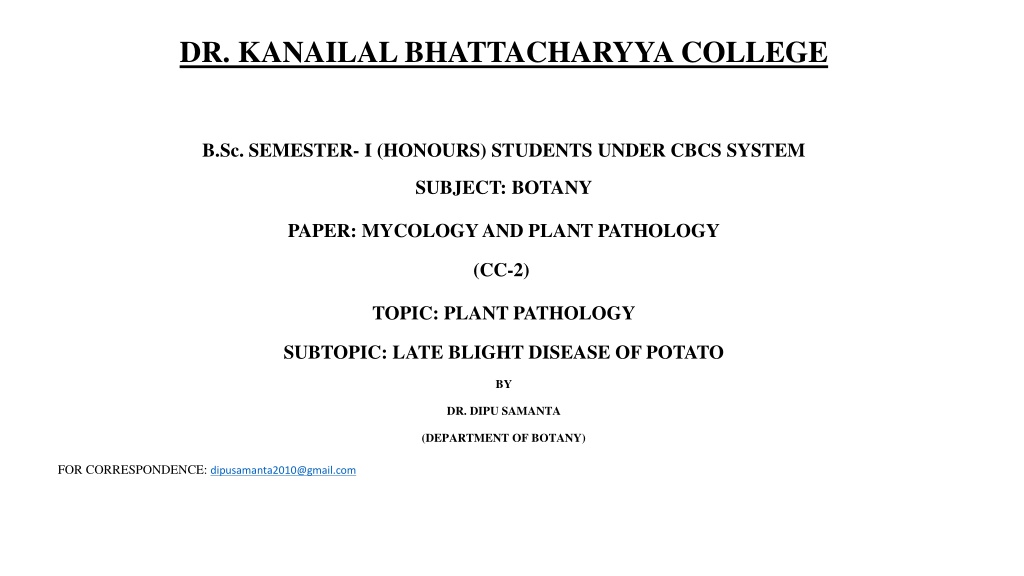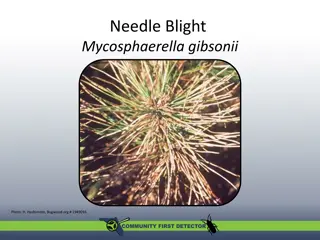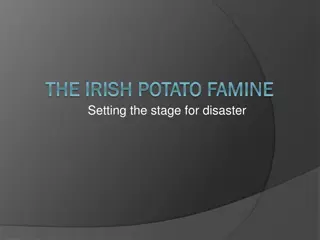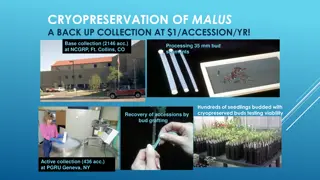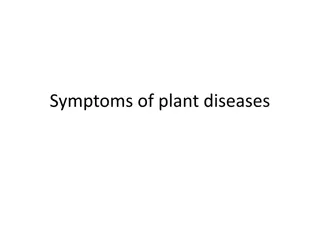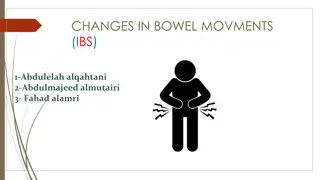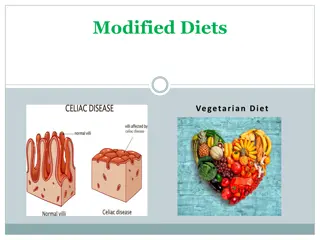Late Blight Disease of Potato: Symptoms and Management
Late blight is a severe fungal disease affecting potatoes worldwide, causing foliage damage, reduced tuber yield, and decay. It is caused by Phytophthora infestans and manifests as brownish-black lesions on plant parts. The disease spreads rapidly under humid conditions, leading to blighting of foliage. Inspection reveals characteristic fungal growth. Management involves early detection, proper sanitation, fungicide applications, and crop rotation to minimize impact on potato crops.
Download Presentation

Please find below an Image/Link to download the presentation.
The content on the website is provided AS IS for your information and personal use only. It may not be sold, licensed, or shared on other websites without obtaining consent from the author. Download presentation by click this link. If you encounter any issues during the download, it is possible that the publisher has removed the file from their server.
E N D
Presentation Transcript
DR. KANAILAL BHATTACHARYYA COLLEGE B.Sc. SEMESTER- I (HONOURS) STUDENTS UNDER CBCS SYSTEM SUBJECT: BOTANY PAPER: MYCOLOGY AND PLANT PATHOLOGY (CC-2) TOPIC: PLANT PATHOLOGY SUBTOPIC: LATE BLIGHT DISEASE OF POTATO BY DR. DIPU SAMANTA (DEPARTMENT OF BOTANY) FOR CORRESPONDENCE: dipusamanta2010@gmail.com
LATE BLIGHT DISEASE OF POTATO Late blight is a serious fungal disease of potatoes. It is worldwide in its distribution. It occurs in potato growing areas of the world. Winter is the main potato growing season in India. It is followed by hot summer months in the plains. The drought and high temperature kill the fungus in the soil. The damage caused by the disease is frequently very high. Severe damage to the foliage shortens the growing season. Consequently the tubers remain small and reduced in weight. They are produced in smaller numbers. This results in the reduced yield. In severe cases of infection there is complete loss of the crop, Infection also results in the decay of tubers in the field and storage. Causal organism: Phytophthora infestans
SYMPTOMS OF LATE BLIGHT DISEASE OF POTATO The disease first appears on the tops of the plants generally after the blossoming period but mostly in the month of January. It may appear as well at any time during the growth period of the plant. The disease makes its appearance as small, dead, brownish to purplish black areas or lesions. These appear on the tips and margins of the leaflets, rachis, petiole and stem. Under favourable conditions (low temperature and high humidity) the lesions rapidly increase in size involving the whole surface of the leaf. The disease generally first attacks the leaves, and petioles near the ground and the lesions appear on the lower surface of the leaflets on individual plants and then spreads upwards. Finally, a rapid and general blighting of foliage occurs. The blighted leaves curl and shrivel in dry weather. Under moist conditions they decay and emit a characteristic offensive odour.
Examination of the lesions on the lower surface of the leaf on a dew morning reveals a delicate growth of the fungus parasite in the form of whitish powdery bloom. It consists of sporangiophores and sporangia of the pathogen pushing out through the stomata. The sporangia serve to spread the disease in the growing season. Potato tubers are often infected in the field after the tops have been blighted. They get separate infections while in the hill. There is brownish discoloration of the skin of those parts of the tubers which lie nearest the surface of the soil. These dry rot spots remain firm and extend to about half an inch below the surface. During storage, the bacteria assist to set in the wet rot phase. In cool and dry conditions the progress of the disease is slower and the wet rot phase is generally checked. Under moist conditions hyaline mycelial hyphae and sporangiophores push out through the lenticels and appear on the surface of infected tubers.
Infected leaf Infected tuber FIG. SYMPTOMS OF LATE BLIGHT DISEASE OF POTATO
FIG. DISEASE CYCLE OF LATE BLIGHT DISEASE OF POTATO
CONTROL MEASURES OF LATE BLIGHT DISEASE OF POTATO Various methods of control of the disease are known. These are: 1. Selection of Seed (Planting) Tubers: The seed tubers should be free from the disease. This requires strict seed tuber inspection at the cutting time. This measure will eliminate direct infection. 2. Storage of Tubers at 40 F or below: Storage of potato tubers in cold storage rooms reduces or even checks the progress of the rot. 3. Growing Disease Resistant Varieties: Considerable success has been achieved in the perfection of resistant varieties of potato. 4. Sanitation: Destruction or proper disposal of potato tuber refuge from pits and store houses is another practical measure to reduce the incidence of disease.
5. Use of Fungicides: Resistance alone has not effectively checked the disease. Therefore the complete control of blight is accomplished by the application of protectant fungicides. These are applied before infection for effective control in two ways namely by spraying or dusting as follows:- 5a. Spraying: The best method of control is the timely and repeated foliage spray schedule with copper fungicides such as Perenox, Blitox-50 and Fytolan. Dithane Z-78, and Dithane M-22 have proved more effective than the copper fungicides. The spraying should start when the plants are 8 inches tail. 5b. Dusting: Dusting the foliage with copper-lime dust is a more effective control measure. Dusting is done in the morning when the plants are wet with dew. 6. Tuber treatment before storage: The tubers should be dipped in 1:1,000 mercuric chloride solution for 90 minutes before storage. Before use they should be washed. 7. Avoidance of injuries to tubers at harvest is also important. 8. In cool humid areas killing of foliage a few days before harvest proves beneficial.
